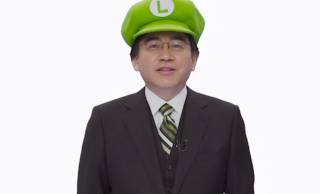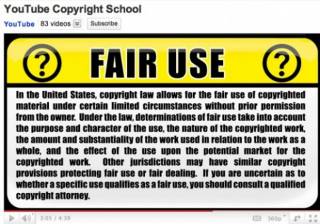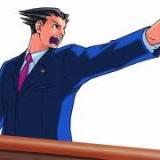It's a-me [copyrighted character]! - Part II (Blog Post)
By LawGamer 10 Comments
Part I of this series started by going over some basic copyright terms and explaining some of the underlying purposes of copyright law. This portion will try to explain just what’s happening between Let’s Play and Nintendo. I thought it would be easiest to structure this in a question and answer format in order to hopefully avoid Wall of Text Syndrome (now with Shiny Pictures!).
Q: So what is Nintendo doing exactly?
Before getting to this, let’s get straight what Nintendo isn’t doing:
- They aren’t suing Let’s Play creators for copyright infringement. No federal court is involved . . . yet. This is purely a dispute between Let’s Play and Nintendo, with YouTube standing in the middle.
- They aren’t issuing a takedown notice under the Digital Millenium Copyright Act . . . yet, although this is probably the next likely step if the situation escalates in some way. For those who aren’t aware, the DMCA allows those who feel someone is violating their copyright with material posted online to send a takedown notice to the service hosting the allegedly violative material. This usually results in the offending content being taken down. If you’ve ever clicked on a video in a link and received a notice along the lines of “this video is no longer available” there is a good chance that this is what has happened.
Q: Would you please answer the question? What is Nintendo is doing?
Nintendo is trying to enforce YouTube's "Content ID" system.
Q: Alright, but what’s the Content ID system?
The Content ID system allows participants like Nintendo to define items they feel they own a copyright to by submitting a sample set of their own content. Whenever new content is uploaded, it is checked against a database containing this information and flagged if the system feels it is violating a copyright claim on the list. If content gets flagged, then certain actions are automatically applied based on the copyright holder’s preference. Right now, there are three options available.

- The copyright holder can monetize the content. This means that ads are placed in the middle of the content, with the revenue going to the copyright holder.
- The content can be blocked.
- The content can be tracked. If this option is chosen, then nothing happens to the video, but the copyright holder gets analytics data about how the content is viewed.
As near as I can determine, Nintendo became part of the Content ID system and sent in a bunch of sample content, which is now causing the Let’s Play videos to get flagged. Nintendo apparently elected the “monetize” option as what they want to do with allegedly infringing content. Since the Let’s Play videos were already getting ad revenue, the videos themselves are unaffected, but all the ad revenue now goes to Nintendo rather than the creators of Let’s Play.
Q: Doesn’t Let’s Play get some sort of say in this process?
Technically, yes. If a YouTube user’s content gets flagged, they have two options. They can either accept YouTube’s judgment on the matter, or they can appeal. If they chose to appeal, one of two things will happen. The person or entity claiming copyright can either withdraw their request, in which case the user wins, or the copyright holder can proceed to sending a formal legal copyright notice under the DMCA, which will almost certainly result in the at-issue content being taken down.
Although this seems perfectly fair in theory, the appeals process does come with a pretty significant stick; if the copyright holder doesn’t withdraw their claim and files a takedown notice, then the accused user receives a “strike” against their account. If a user racks up three strikes, their account gets suspended and all of that account’s videos are removed, even the ones not subject to a Content ID claim. There are a couple of things that I found sort of shocking about the way the process is structured:
- First, YouTube is pretty hands off in the whole process. Actually, this one isn't all that surprising if you know anything about the DMCA, but it might shock people not familiar with it. When an appeal is made, all YouTube does is provide the user a form to state the reasons they are disputing the claim. This form is then sent to the accuser who uses the form to determine whether or not they want to pursue their claim or not. At no point is YouTube involved in evaluating the validity of the Content ID case. This means that the accuser is pretty much the judge, jury, and executioner of their own claim.
- Second, there doesn’t appear to be any further steps to the process; if the accuser wants to file a takedown notice that’s that, and the user receives a strike agains their account. A lot of user agreements provide for some sort of arbitration in the event of an intractable dispute. As far as I can determine, the YouTube user agreement doesn’t even contain the word “arbitration.”
- Third, there doesn’t seem to be any process for removing strikes once they have been issued, beyond the listed six-month waiting period. Since there is no language to the contrary, this apparently means that the strike would remain even if the user took the copyright holder to court and won.
Q: Wow, isn’t this whole process just a lazy jerk move on YouTube’s part?
It might look that way given the limited options available to users whose content has been flagged, but really this is just YouTube looking out for its own best interest. You see, under traditional copyright law not only is the person actually violating the copyright liable for their infringement, but also anyone who helped that infringement in a secondary capacity. This means that under traditional copyright law, YouTube could face a lawsuit for “secondary infringement” for every video that goes up that containing copyrighted material. Given that between the user and YouTube, YouTube is the one with the “deep pockets” to pay damages in a lawsuit, this could mean that YouTube would be the one actually getting sued in most cases, which would quickly become a problem.
It was partly for this reason that Congress passed the DMCA. Under its provisions, “Internet Service Providers,” a category in which YouTube falls, are provided with a “safe harbor” where they will not be considered to be secondary copyright infringers provided that they follow the DMCA’s process for managing takedown notices. When you get right down to it, the Content ID system is really just a practical implementation of the DMCA’s “safe harbor” provision. As to why YouTube won’t get involved in mediating the disputes, there are really two answers. First is that they don’t want to mediate a dispute, have the losing party take the issue to federal court and have a federal judge say they were wrong. This would end up exposing them to the very liability they are hoping to avoid. Second, YouTube has a massive number of videos. They receive literally thousands of takedown notices a day. Going through every one would be too costly and time consuming, so it is easier to just take down the videos preemptively whenever they receive a DMCA notice.
Q: Alright, so what other options are available to Let’s Play?
Well, they have a couple, although neither one is particularly appealing. First, they could go what could be called the “contractual” route. This would involve attempting to argue either that the terms of YouTube’s Content ID system don’t apply to them, or that Nintendo somehow did not comply correctly with the requirements. Unfortunately for Let’s Play, this doesn’t seem likely to succeed. By posting on YouTube at all, Let’s Play agreed to YouTube’s terms of service, and those terms of service are pretty clear about the applicability of the Content ID system. In fact, it has several pages just going over how the system works. As for Nintendo doing it wrong, well, Nintendo has enough lawyers to populate a small asteroid and many of them likely deal exclusively in intellectual property law. I wouldn’t be surprised to discover that they have an entire team of lawyers dedicated to just managing DMCA takedown notices. In other words, there is always a chance they could have done it wrong, but I wouldn’t count on it.
Q: You just said they had a “couple” of options. What’s the other one?
The other option available to Let’s Play is to claim that their videos constitute a “fair use” of Nintendo’s copyrighted material. “Fair use” is an exception to copyright law stating that under certain circumstances, the public is allowed to use copyrighted material without the copyright holder being able to sue them. For example, material may be used for criticism or education without being able to trigger a copyright claim. There are four factors that get examined when looking at whether something qualified for the “fair use” exception:

- The purpose and character of the use, including whether such work is of a commercial nature or is for non-profit or educational purposes
- The nature of the copyrighted work
- The amount and substantiality of the portion used in relation to the copyrighted work as a whole
- The effect of the use upon the potential market or value of the copyrighted work
Most of the debate on this issue is going to center around the first factor, which is also the one that the US Supreme Court has labeled the “primary” factor. The central examination taking place under this factor is whether the work claiming fair use is “transformative” in nature. If this seems really vague and unhelpful, that’s because it’s intended to be that way. Congress and the courts don’t want to strictly define the term and potentially limit some future legitimate use of the material. Therefore, it would be a mistake draw conclusions about Let’s Play videos simply by taking the dictionary definition of “transformative” and applying to say that the fair use exception applies (or doesn't). That said, most “transformative” works are held to fall into two categories; parody and commentary/criticism.
Since the Let’s Play videos are pretty clearly not parody, their only real chance of falling into the fair use exception is to qualify as a “commentary” on the gameplay. Obviously, your feelings on this matter are going to turn heavily on just what you feel a “commentary” is. Nintendo would certainly argue that “commentary” means something more substantial than a bunch of guys sitting around talking about playing a video game and that the term implies something a little bit more critical than what amounts to a “Long Look.” On the other hand, if you define commentary as “a descriptive spoken account of an event or performance as it happens,” then you probably think that Let’s Play qualifies. They are after all, describing their experience with a game as they are playing it, which seems to fit that definition.
Given that there is support for both sides, I would point out that this is an examination of just one of the four factors. The other three tilt more against Let’s Play; they are for-profit videos and those tend to receive less fair use protection than non-profit or educational videos. This puts them at risk under factor number two. Additionally, they show substantial portions of a game, in some cases the entire game. This puts them at odds with factor number three, which gives less protection to items that display significant portions of a copyrighted work. In other words, Let’s Play videos are likely going to have a hard time qualifying under fair use.
Q: Why is Nintendo doing this? It seems like a case of cutting off your nose to spite your face.
Obviously the answer to this question will necessarily involve a good deal of speculation. We aren’t privy to the discussions within Nintendo corporate headquarters. That said, I think there are largely two possible reasons why Nintendo decided to suddenly get involved:
First is money. Let’s Play videos have been steadily growing, both in number and as a source of revenue. Given that Nintendo didn’t issue takedown notices but instead chose to siphon the ad money into their own pockets, it seems plausible that they merely want their cut. However, there are a couple of problems with this theory. For one thing, even given their recent less than stellar track record Nintendo still makes eleventy bajillion dollars a year. Any ad revenue they pull in from Let’s Play is hardly going to amount to a drop in the bucket for them. As many have mentioned, this seems like Nintendo shooting themselves in the foot. Additionally, the Let’s Play videos amount to free advertising and exposure for Nintendo’s games, possibly encouraging others to purchase their products. Suddenly being aggressive with their copyrights only serves to reduce the number of people who will be willing to post that material, cutting off both the source of free marketing and any ad revenue generated from the content. For those reasons, I don’t think that money is the reason, or at least not the primary reason for Nintendo’s actions.
The second reason, and the one I suspect is driving Nintendo, is the ability to control their brand and what gets said about their games. Nintendo has always seemed pretty careful about defining themselves as the “family friendly” video game company, particularly when it comes to properties like Mario and Zelda. Although the Let’s Play videos do provide them with a means of free advertising, Nintendo also don’t have control over what gets said. It is entirely possible that Let’s Play could put up a video that bashes a Nintendo game and actually decreases interest in that game. They might also produce a video that juxtaposes something like Mario with more salacious material, which risks damaging the perception of the brand. They might feel that the damage they do to themselves with gamers in the short-term is a worthwhile cost to pay for maintaining a tight control over what get associated with their brand.
Whatever the reason for their actions, keep in mind a couple of things before jumping to conclusions about Nintendo being evil and/or stupid. First, Nintendo legally owns the copyrights to their games and characters, and that gives them the legal right to determine how that content is used, including sending DMCA takedown notices or making claims under the YouTube Content ID system. However, just because they have the capacity to do it doesn’t necessarily mean they are wise to do so. If I were their attorney, I would absolutely have brought up the possibility of bad PR in taking these actions. However, as you quickly find out as a lawyer, your clients don’t actually need to listen to you. If the issue was even brought up, they might have ignored any advice they received. Or maybe they did listen to their advice, which brings me to the second point.
Just because you or I think that this is shortsighted and stupid on Nintendo’s part doesn’t mean they weigh things the same way. The managers of the company obviously have access to more data than we do about the internal workings and long-term strategy of the company. It is very possible that the issue of bad PR and long-term damage was brought up. It is also possible that they took this possibility very seriously, but in the end decided that there were more important factors to take into consideration long term.
And on that note, we will conclude this second edition on this topic. Hopefully, I will get around to writing on whether this whole issue suggest that copyright law needs an overhaul or not, which is something that should hopefully engender discussion rather than merely being an long-winded explanation. If I do, it would probably be sometime next week or the week after. As always, if you have questions, leave them in the comments and I'll try to get to them.
EDIT: Part III is now up.
